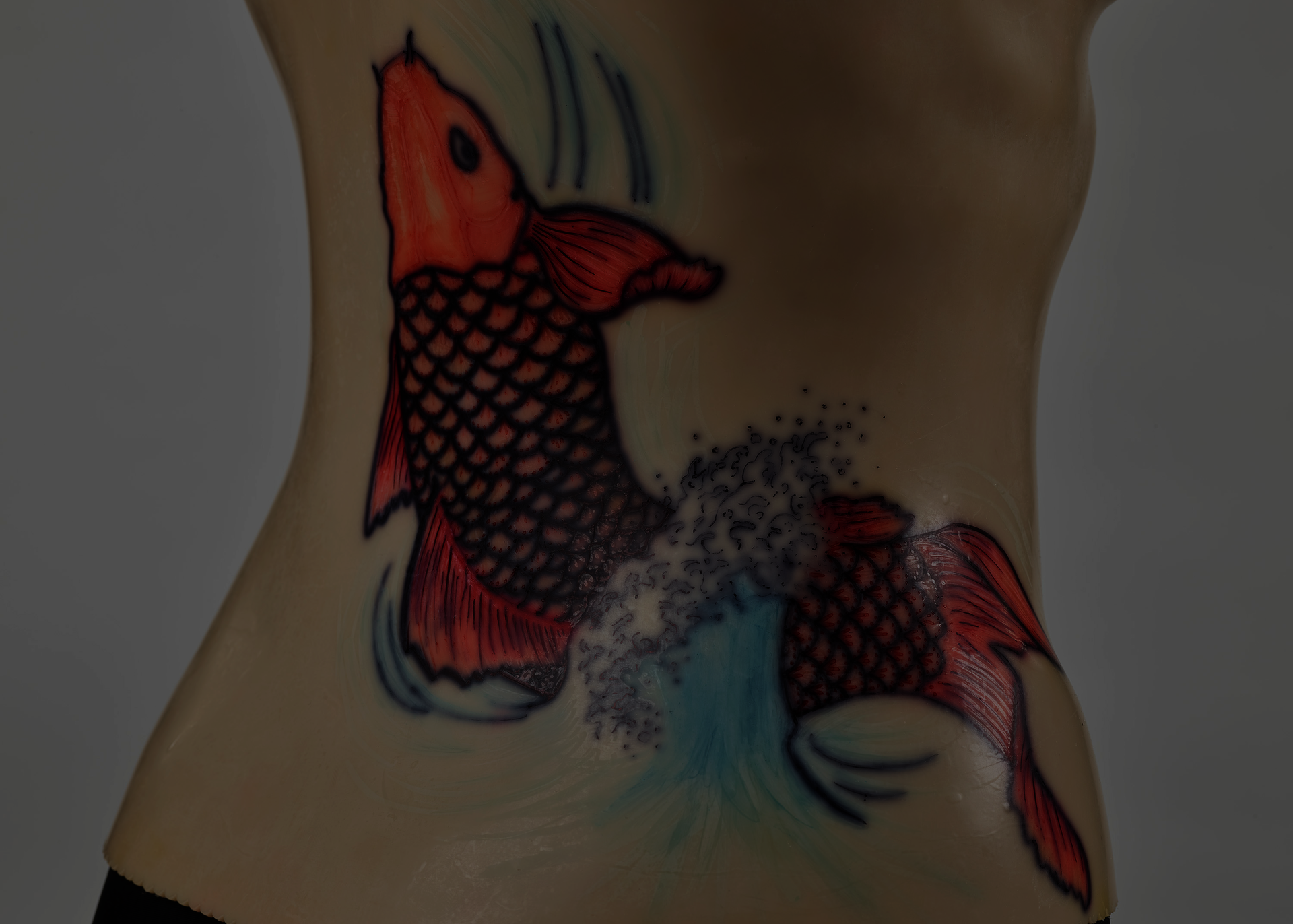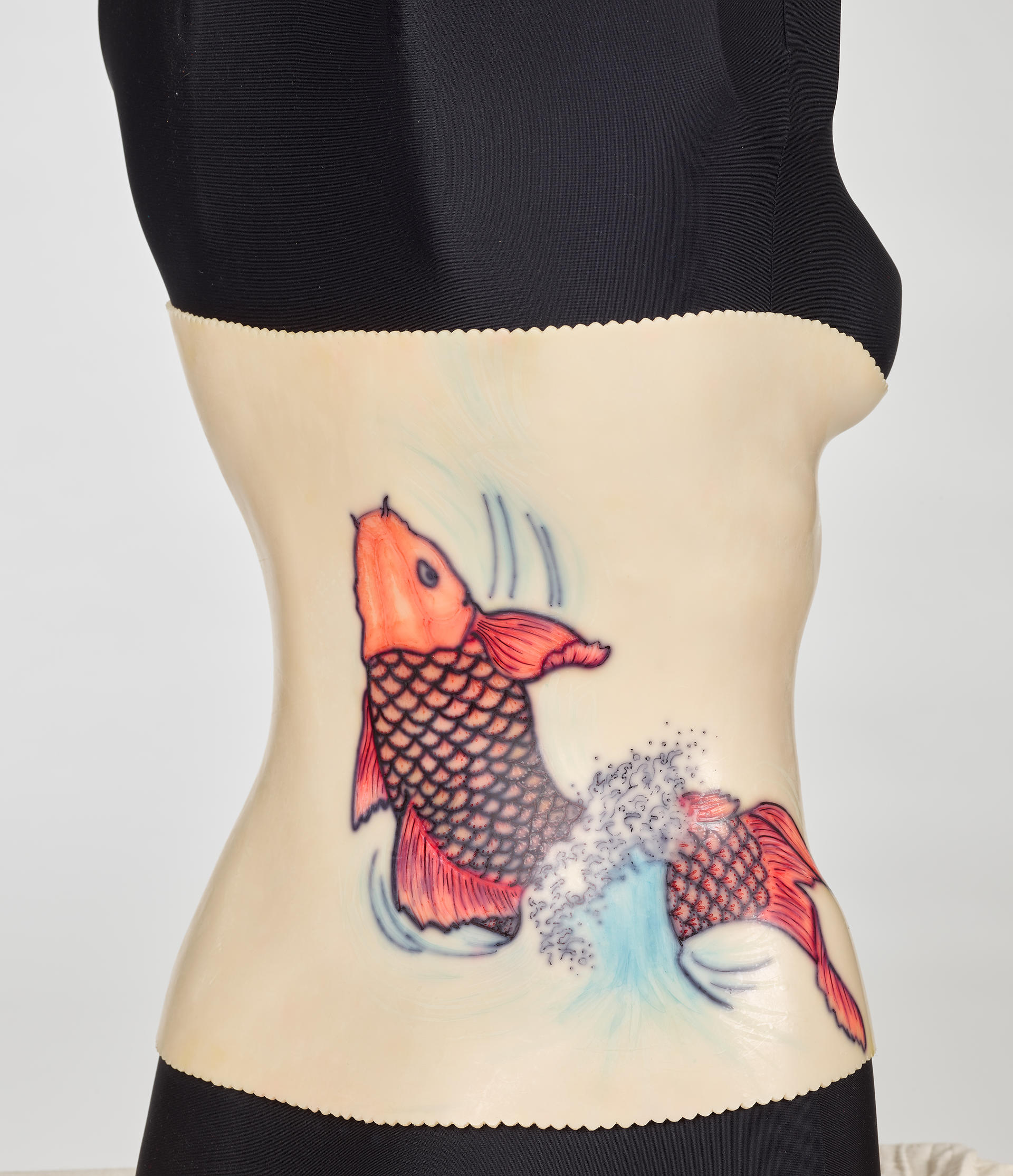Image

DOUBLE TAKE
Lanzavecchia + Wai
Tattoo Back Brace
Sky Cubacub / Ellen Samuels
Lanzavecchia + Wai Designers
Singapore and Italy, 2010–present
Francesca Lanzavecchia
Italian, b. 1983
Hunn Wai
Singaporean, b. 1980
Tattoo Back Brace, 2008
Polycaprolactone
Georgianna Sayles Aldrich Fund 2012.57
Image

Sky Cubacub
—
My own work with Rebirth Garments is all about Radical Visibility—an unapologetic refusal to assimilate, a claim to our bodies, and a celebratory insistence on highlighting the parts of us that society typically shuns. But I love the dance between the dichotomy of simultaneously blending in and standing out in Lanzavecchia + Wai’s Tattoo Back Brace. Dyed to match the skin tone of the wearer, it portrays a koi-fish tattoo in a traditional Japanese style, so it is semicamouflaged (pretty pataphysical), but stands out because it’s a sexy couture back brace that differs greatly from the current strictly medicalized braces, creating a double take for passersby. The material is polycaprolactone, a biodegradable polyester that has many medical uses and can be fully integrated with your body as dermal filler or root-canal filling. Since these back braces are dyed and molded to fit, I am longing to see these designs on people with a bigger variety of body shapes and skin tones. I think it would push the concept even further.
As a heavily tattooed and pierced person, I love thinking about body mods on prosthetics with this particular type of im/permanence. This brace gives me echoes of QueerCrip icon Frida Kahlo’s hand-painted back braces. A friend of mine had a fabric I designed embedded into their last two prosthetic legs. (One of those fabric patterns is also tattooed on me, and came from a shape language I first developed around drawing shapes on my face as a teen.) Adding designs like these allows the user to choose a new permanent tattoo every time they get a new prosthesis, which happens every few years (ideally).
Like Lanzavecchia + Wai, I understand wearables to be our second skin. This foundation has the power to change the way we hold ourselves, giving us the confidence and strength to feel comfortable in our first skin. Feeling confident in our outward appearance can revolutionize our emotional and political reality, so I am also very interested in making our second skins into something desirable to touch, wear, and see. All of the back braces in this collection by Lanzavecchia + Wai are very attractive, taking Issey Miyake’s and Thierry Mugler’s futuristic plastic breastplate aesthetics of the 1980s to a new level of functional-disability jubilation.
Crip Futurism is about the visibility of disabled joy and expression; it sees the future of fashion as intersectional, accessible, and celebratory. Everything we wear can be used as a personal art platform to express our pride in the intersections of our identities. If we celebrate our identities, this helps other people in our communities to discover their own identities and feel seen. And this opens the community and world to a future that is happening now!
Image

Image

Ellen Samuels
—
I thought of the coarse white flesh
packed in like feathers,
the big bones and the little bones . . .1
Sometimes when poets write about fish, they mean bodies. Or bodies mean water. Or water means shells’ pink bellies turned upward in tidal silt, sand trailed in the shape of a tracing hand.
But sometimes a body is only a body, singular stone, settling to bottom in the slow green, in the laddered scars hemming your spine.
Before our bodies separated, knife slid clean between scales and skin, I knew those scars. I knew you through them.
shapes like full-blown roses
stained and lost through age
It’s one sort of genius to see muscle and joint inside slick marble, know the chisel’s exact pitch to reveal each limb. But quite another when the body’s there first, wrapped in wet plaster, holding its breath while the shape hardens, bone surfaced through skin into carapace, ivory, shield.
The brace is not to hold you together but to hold you in. That’s why you can color it like skin, needled vermillion and aquamarine.
Sometimes when artists draw pictures of bodies, they mean fish, they mean ripples, they mean riptides, rising from deep inside.
If you should dip your hand in,
your wrist would ache immediately,
your bones would begin to ache and your hand
would burn . . .
Under every brace is a second layer no one knows about, cotton mesh, stocking net. I keep a chest of smooth shed skins, raveled and graying.
You need that layer between brace and flesh. Between body and world. Between the quiet water and the sudden hooked lip.
You are red at the edges and sore with time. Every night undoing the laces, unbuckling the straps, paring brace from skin still grooved in its image.
Held fast. Held tight. Held in the moment of air-thirst panic, shudder and flop, you the gleaming exquisite dancer, you the crooked river bed, you the froth seething at the world’s edge.
Image

-
Inset quotations are from two poems by Elizabeth Bishop, “The Fish” and “At the Fishhouses,” from The Complete Poems, 1927–1979 (New York: Farrar, Straus & Giroux, 1983), https://poets.org/poem/fish-2 and https://www.poetryfoundation.org/poems/52192/at-the-fishhouses.
Cite this article as
Chicago Style
MLA Style
Shareable Link
Copy this page's URL to your clipboard.

